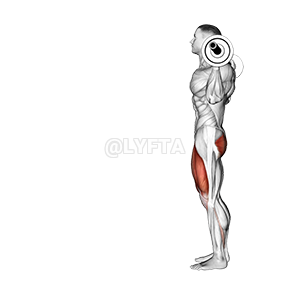
Barbell Lunge
Exercise Profile
Related Exercises:
Introduction to the Barbell Lunge
The Barbell Lunge is a dynamic strength training exercise that targets several muscle groups including the quadriceps, glutes, and hamstrings, making it an excellent choice for overall lower body development. It's suitable for everyone, from beginners to advanced fitness enthusiasts, due to its adjustable difficulty based on the weight used. Individuals may want to incorporate this exercise into their routine for improved balance, enhanced core stability, and to boost functional strength for daily activities.
Performing the: A Step-by-Step Tutorial Barbell Lunge
- Take a big step forward with your right foot, keeping your core engaged and your spine straight.
- Lower your body until your right knee is bent at a 90-degree angle, and your left knee is hovering just above the floor. Ensure that your right knee is directly above your right ankle.
- Push off your right foot to return to the starting position, keeping your weight in your heels.
- Repeat the movement with your left foot, alternating legs for the desired number of repetitions.
Tips for Performing Barbell Lunge
- Appropriate Weight: Use a weight that is challenging but manageable. A common mistake is to use too much weight, which can lead to improper form and potential injuries. Start with a lighter weight and gradually increase as your strength and form improve.
- Control Your Movement: Avoid rushing through the exercise. It's better to perform each lunge slowly and with control, rather than trying to do as many as possible in a short amount of time. This ensures that your muscles are fully engaged and reduces the risk of injury.
- Warm Up: Before starting the exercise,
Barbell Lunge FAQs
Can beginners do the Barbell Lunge?
Yes, beginners can do the Barbell Lunge exercise. However, it's important to start with lighter weights to ensure correct form and prevent injury. It's also recommended to have a trainer or experienced individual supervise or guide you through the exercise initially. As you become more comfortable and your strength improves, you can gradually increase the weight.
What are common variations of the Barbell Lunge?
- Walking Lunge: In this variation, you perform a lunge and then step forward into the next lunge, effectively walking forward.
- Reverse Barbell Lunge: This is a lunge where you step backward instead of forward, which can help focus more on the glutes and hamstrings.
- Side Lunge with Barbell: Instead of lunging forward, you lunge to the side, which can help work the inner and outer thighs.
- Overhead Barbell Lunge: In this variation, you hold the barbell overhead while performing the lunge, which can help engage your core and improve balance.
What are good complementing exercises for the Barbell Lunge?
- Deadlifts: Deadlifts complement barbell lunges by targeting the posterior chain, including the hamstrings, glutes, and lower back, which are crucial for maintaining balance and stability during lunges, and they also help in improving overall body strength and posture.
- Step-ups: Step-ups, like barbell lunges, are a unilateral exercise that helps improve balance, coordination, and unilateral strength, while targeting the same muscle groups, such as the quads, glutes, and hamstrings, making them an excellent addition to a workout routine that includes barbell lunges.
Related keywords for Barbell Lunge
- Barbell Lunge workout
- Quadriceps strengthening exercises
- Thigh toning with barbell
- Barbell exercises for legs
- Lunge variations with barbell
- Strengthening thighs with barbell lunges
- Barbell Lunge technique
- Barbell workouts for quadriceps
- Lower body workout with barbell
- Barbell Lunge for leg muscle building











